
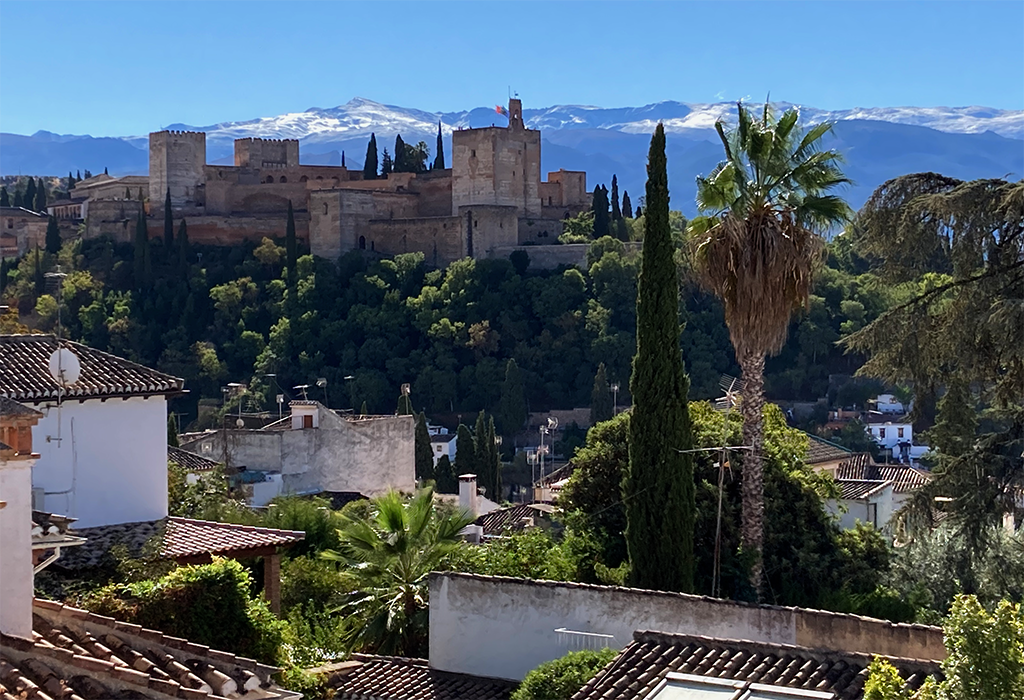
The Albaicín. This week, I’ll start with our Granada neighborhood. The Albaicín (also from the Arabic, Albayzin) is on a hill on the north side of the Darro River. For the most part, it has retained its medieval street plan dating back to the Nasrid era (13th to 15th centuries), although the community went through significant changes after 1492. It was declared a UNESCO World Heritage Site in 1994, as part of the Alhambra’s designation.
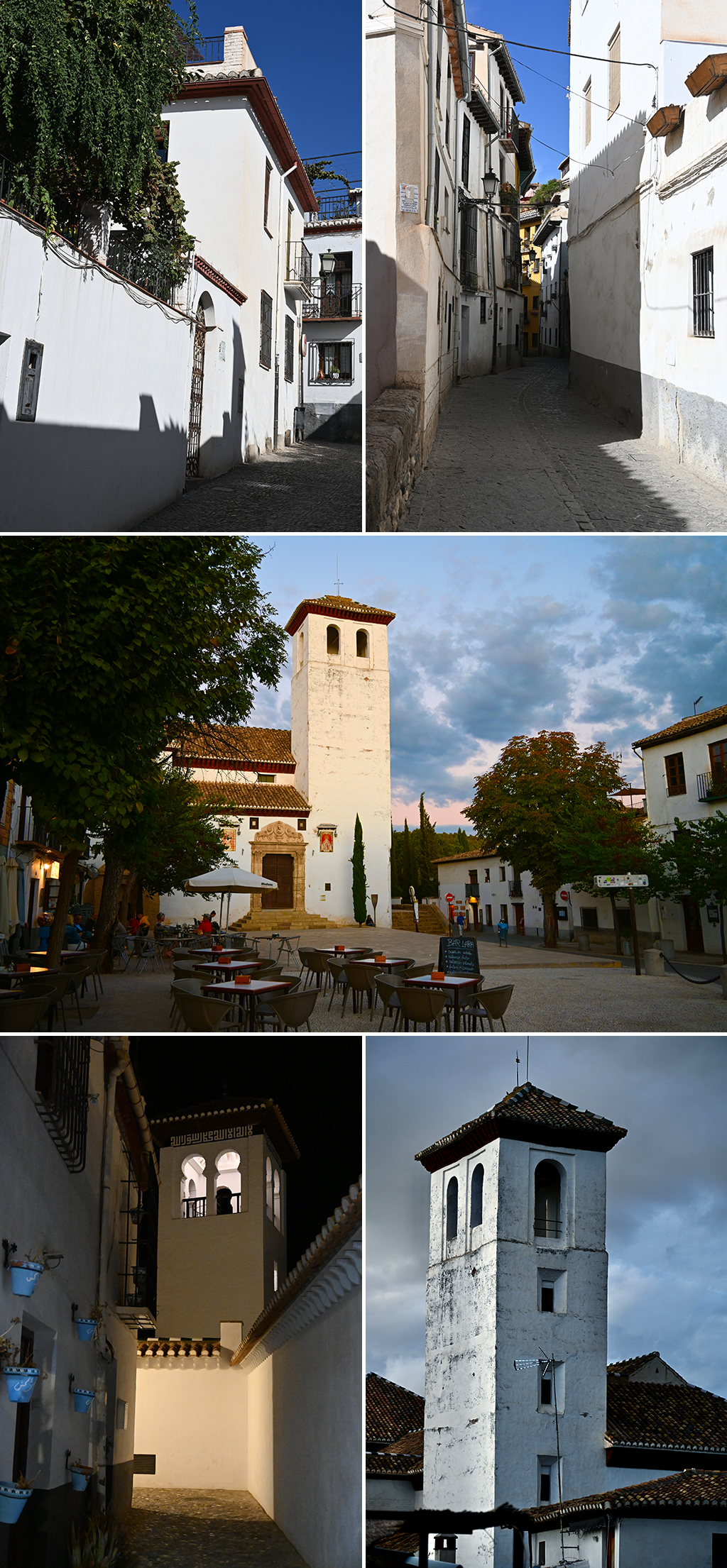
The neighborhood is a warren of cobbled streets, many of which are more like steep ramps or staircases than actual streets. When you go out for the day, which usually entails going downhill, you have to know that your return to the top is steep and exhausting! By the end of the week we were getting used to it, though.
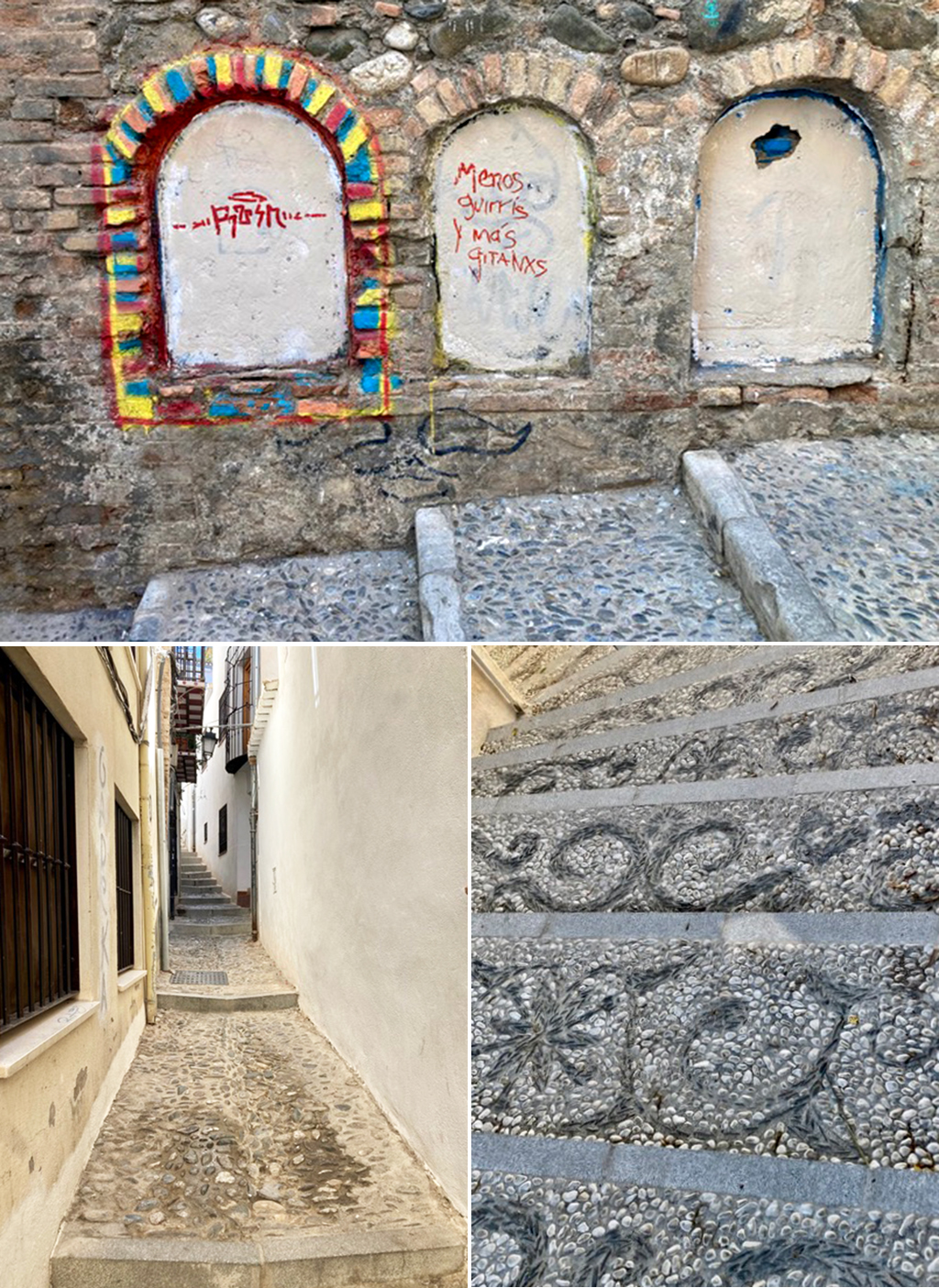
A few minutes’ walk from our apartment is the Mirador de San Nicolás. This is perhaps the best known of the several miradors on that Granada hillside. Miradors are “lookouts” — but I want to make a false translation that is decidedly more romantic: golden views, for that they are. The prospect from San Nicolás has perhaps the most golden view of all the miradors; it looks directly across the valley to the Alhambra, which seems to float in its forest by day, and in the dark sky by night.
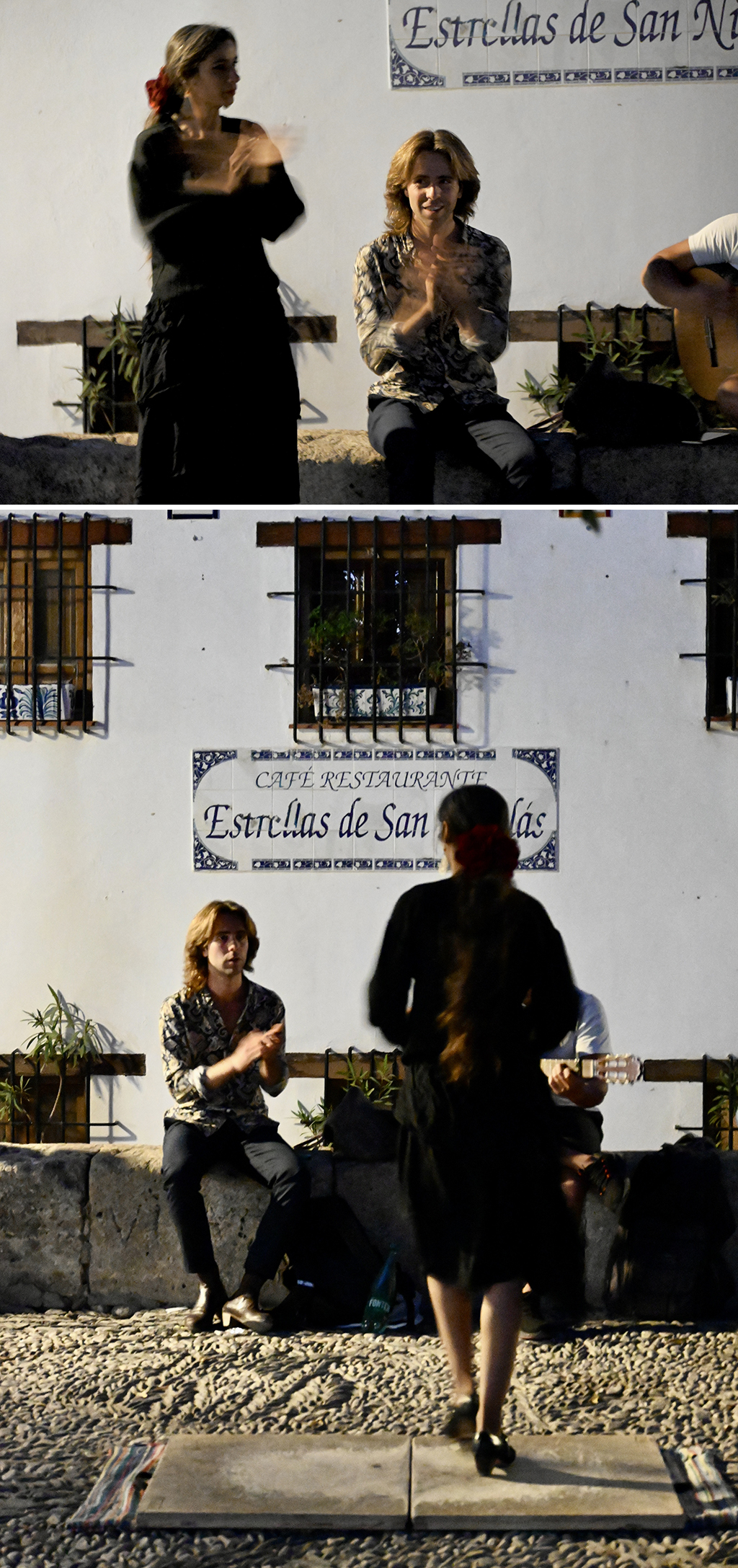
We mostly visited this particular mirador in the evening, to gaze at the view, watch the hordes of young people as they talked, laughed, or stole kisses in the shadows. We enjoyed the flamenco performers, who seemed to be there nightly. One evening, we noticed the Iglesia de San Nicolás was open. We made a donation and went in to find a beautiful modern interior that has been evolving since it was severely damaged in the Spanish Civil War in the 1930s. It was really nice to see contemporary artwork that conveyed religious narratives with considerable diversity.

Catedral de Granada and Capilla Real (Royal Chapel)
Downtown, in the valley, stands the cathedral — the city centerpiece. Magnificent in scale, this immense building is crowded in by narrow streets, so views of its upward thrusting spires come as wonderful surprises, often in slivers. It was begun about twenty-five years after Ferdinand and Isabella conquered the ancient city, a time when Spain had not caught up with the renaissance of the rest of southern Europe. So the building is a strange melding of late gothic structure with renaissance detailing. It has two side aisles including side chapels, and two transepts,— all gleaming white. Ornament continued to accrue through successive generations, which adds interest and richness of texture.
Notes: no photos are permitted in the Capilla Real, which houses the effigy tombs of Ferdinand and Isabella, so the photos below are from the main cathedral. Both have admission fees, but there is no need to reserve in advance.
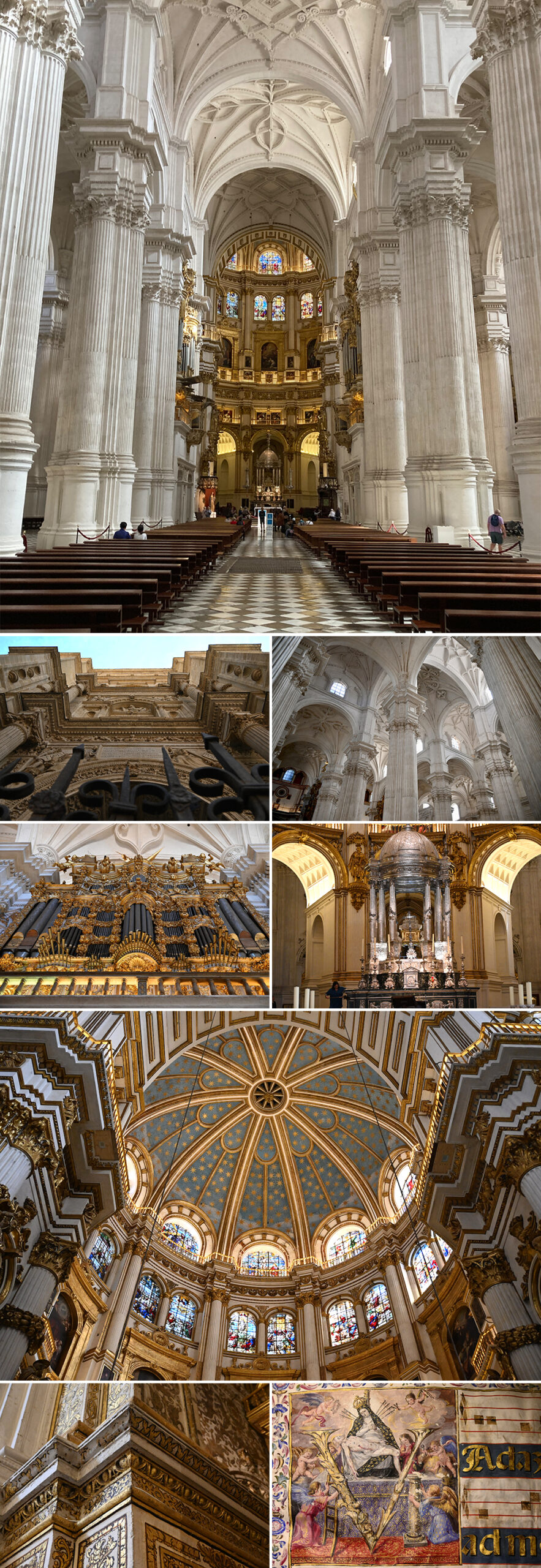
Not too far from the cathedral, you will find the church of San Juan de Dios, built circa 1700-1730. It has a spectacular baroque interior that is gilded, for the most part, from the stone dado up to its cornices, with ceilings painted in oil on plaster. The altarpieces, to create contrast with the general lushness, were worked in extreme high relief of rather mannerist looking columns, abundant niches and statuary, and globs of baroque scrollwork, showing hints of the emergent rococo style.
In the reredos were three central niches, one above the other. The largest and central of these opened to reveal a room with an immense sterling silver reliquary for the remnants of San Juan de Dios, plus a few significant other relics like a purported finger bone of Jesus and a piece of the True Cross. The reliquary room is as gilded as the rest of the church, and by virtue of its relative smallness and numerous additional reliquaries incorporated into the wall, it feels more intensely decorated.
We were left to wonder how a saint, who dedicated his life to serving the poor, would feel about such opulence in his name. To the church’s credit, after five centuries, it still operates a hospital for the poor next door, including a handsome modern building.
Note: there was a modest admission fee, and no reservations are necessary.
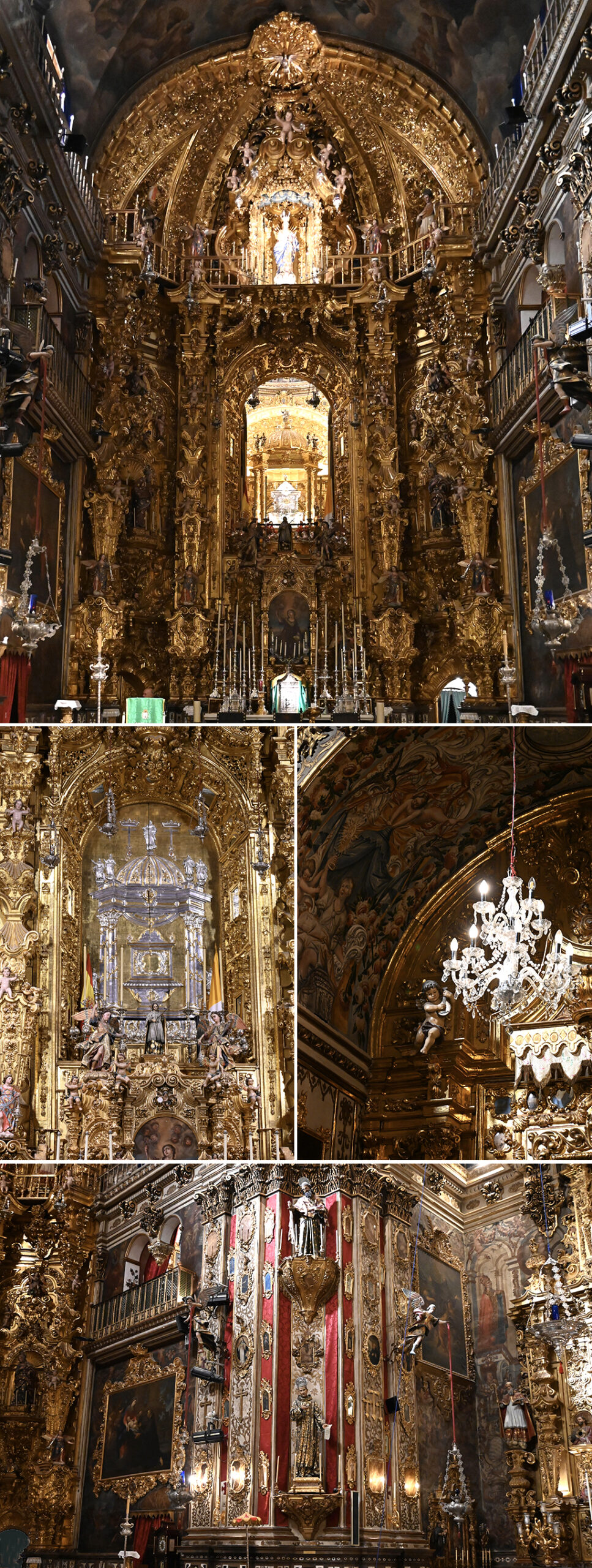
Street Scenes & Street Art.
These photos speak for themselves. I love unique street scenes, and street art (not graffiti) is a favorite of mine.
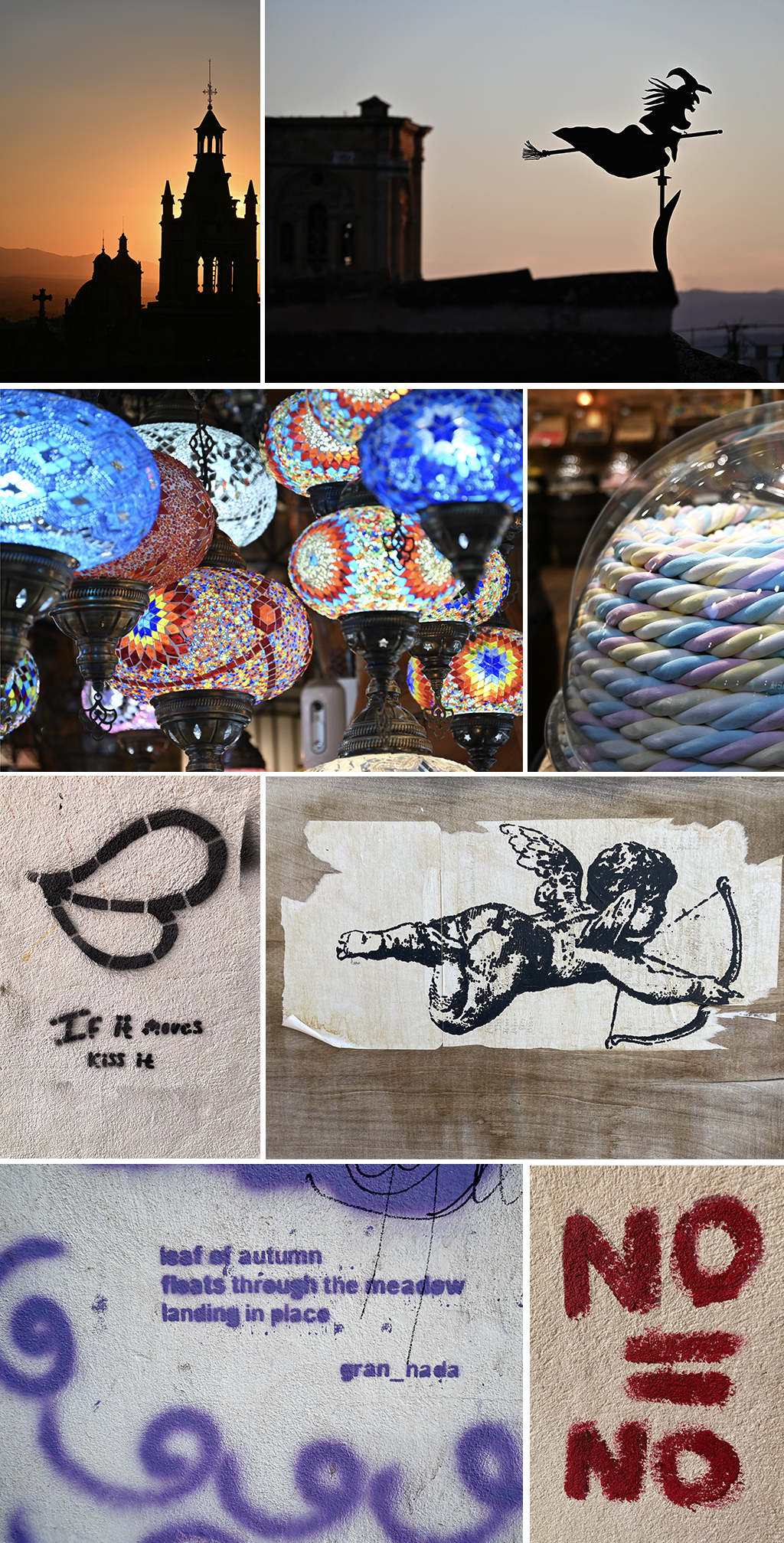
And To Eat?
One of the charms of European cities are the cafes and restaurants with outdoor tables. In northern countries they celebrate the brief summers. In torrid southern countries they provide escape as the evening coolness settles. This summer’s blistering heat was abating, but we understood and began to adapt to the notions of siestas during the afternoon heat, and dinner (preferably under the stars) at 9:00 p.m.
La Mancha Chica Chaouen. (Albaicín) Camino Nuevo de San Nicolás, 1, 18010 Granada, Spain. The owner and chef of this Moroccan restaurant was welcoming, warm, conversational, and delightful. As he is fluent in both Spanish and French it was easy to converse with him. We shared a vegetable couscous and a lamb and prune tagine with almonds; Mark indulged in a mint tea. The food was just great.

Restaurante El Mirador de San Nicolás. (Albaicín) Plaza Cementerio de San Nicolas, 8, 18010 Granada, Spain. Spanish cuisine is justifiably famous for its ham and pork dishes, and we were able to dig in at this restaurant on a quiet plaza behind San Nicolás. Here, we both enjoyed seared slices of Lomo de Cerdo (pork tenderloin) wrapped in Jamón Ibérico, served with potatoes and sweet peppers cooked in olive oil. It was wonderful to eat pork that had such flavor, and all to the sounds of a guitarist.
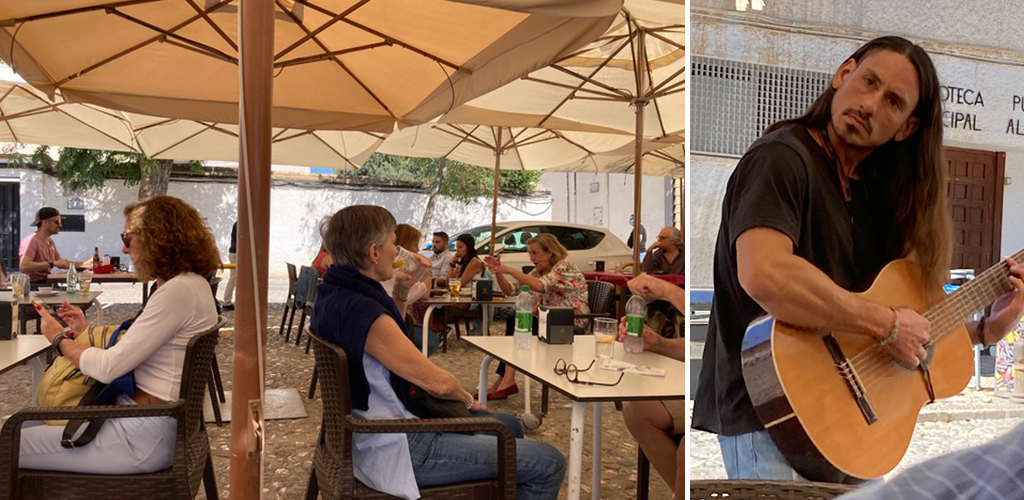
El Ladrillo Charico. (Albaicín) Plaza de Fátima, 4, 18010 Granada, Spain. The province of Andalucia includes extensive coastlines on both the Mediterranean and Atlantic, and El Ladrillo Charico specializes in fish and seafood. We ordered a platter of grilled fish and seafood which would have been plenty but, when asked for her favorite, our server suggest the pijotas (a small hake) and we got those, too. They ended up being our favorite — so sweet a fish — which does prove something I always tell others; ask for recommendations and go for them. Very rarely have I been steered wrong.

Developed and maintained by Inspiratech LLC.
Design by Themeshift.
Mad Dog
November 15, 2022 at 7:13 amMore great pictures!
The graffiti “Menos guirris y más gitanxs” amused me – it means, “Less tourists and more gypsy women.”
Have you read, “South from Granada: Seven Years in an Andalusian Village”, by Gerald Brenan? It’s a facinating account of living in in the region during the years after World War 1.
Cocoa & Lavender
November 19, 2022 at 10:37 amWell, bing tourists, we were amused by it as well – and we tried our best not to be “that kind” of tourist. Even though my Spanish is rudimentary, I never started any conversation with ¿Habla inglese? Thank you so much for the book recommendation – I know we will both love that!
Mad Dog
November 19, 2022 at 12:07 pmThere’s a movie of the book too (Al Sur de Granada), but it’s not as good. Gerald Brenan was so loved by the people of Málaga, that they looked after him in his old age.
Cocoa & Lavender
November 20, 2022 at 2:19 pmI saw the movie listed and wasn’t sure it was the same one. The book is due by the end of the month — I look forward to it.
Donn Poll
November 15, 2022 at 8:08 amBeautiful coverage gentlemen… sumptuous images of the culture are so warm and inviting. Thank you.
Cocoa & Lavender
November 19, 2022 at 10:37 amWe so look forward to chatting with you both about Andalucia!
Corbin Smith
November 15, 2022 at 1:49 pmAwesome and so tempting to make our next adventure – 2024? – there! Your photos are splendid, your narrative muy claro, and thank you so much. One other reading suggestion: “Leo Africanus” by Amin Maalouf, the historical fictional story of a young Arab boy born in 1488 in Granada and his journey to Morocco (expelled, of course by F&I) and then to other parts middle Eastern, eventually to Rome where he advises Leo X on his dealings with the Arab world.
Cocoa & Lavender
November 19, 2022 at 10:39 amThanks, Corbin – that is a great book recommendation. That period id fascinating to us both, especially after having been there.
Marian Jensen
November 15, 2022 at 5:48 pmGorgeous photos and narrative. Saving for my trip! Thank you!
Cocoa & Lavender
November 19, 2022 at 10:40 amThere are several more posts on the way – I know you will love this. Great to see you at the wedding!
Christina Conte
November 15, 2022 at 7:32 pmI’m in awe of the church and cathedral architecture! Wow, just incredible! I’m so wanting to pop back over to Spain now after seeing your last four posts! If only we could travel quicker, easier and with less $$$!
Ron
November 16, 2022 at 12:19 amDavid. I’m so enjoying your series of posts from your recent adventure. The images here are magnificent, so much so that I plan to put your post on our TV tonight. Then we can enjoy it on the big screen while sipping on a glass of vino…
Cocoa & Lavender
November 19, 2022 at 10:43 amThat is such a compliment, Ron – if you did put them on the television, I hope they lived up to your expectations!
Pauline McNee
November 16, 2022 at 3:58 pmYou’ve transported me back to Granada beautifully David. It really was one of my favourite regions of Spain, and the food you were served looks so typically Spanish but also with the Granada flavours. OH THE TAGINES and tapas! Never tire of those beautiful, opulent and gilded churches either, the walking certainly gets the heart rate up doesn’t it, but well worth it. I’ll show this to my husband later, he will love it as well. Not only are you a food blogger, but also an excellent travel blogger. Well done. I’ll have to check to see if I’ve missed any of your Spanish posts so far 🙂
Cocoa & Lavender
November 19, 2022 at 10:46 amThank you so much, Pauline – I am so glad you enjoyed this post. Yes, the food was outstanding – we loved every bite! The tagine was truly outstanding – the Moroccan flavors are just exquisite. And the beauty – unparalleled. You have only missed one post so far (The Alhambra) but there are more coming on Sevilla and Córdoba. I truly appreciate your kind words about my writing!
Raymund
November 16, 2022 at 7:14 pmWow what a really nice post, I felt like I travelled to Granada, missing Spain now
Cocoa & Lavender
November 19, 2022 at 10:47 amSpain is wonderful, isn’t it Raymund? I wish we could all go back now!
luna
November 19, 2022 at 1:32 amsuperbes photos qui font voyager merci !
bonne journée
Cocoa & Lavender
November 19, 2022 at 10:50 amMerci – je suis très content que vous avez apprecié les photos!
2pots2cook
November 19, 2022 at 3:04 amIt wouldn’t be quite right to say Granada is the most wonderful place on the world, at least from our point of view, but it is absolutely amazing and “must see” in one’s lifetime!
Cocoa & Lavender
November 19, 2022 at 10:51 amPerhaps not, but it is really up there among our favorites.
Susan Manfull
November 19, 2022 at 7:56 amBeautiful photos and inspiring words. Lovely way to begin my day with scenes that are bringing back memories from a trip in the early 70s to Granada. Thanks for sharing.
Cocoa & Lavender
November 19, 2022 at 10:54 amOh, how I wish we could have seen Granada in teh 70s – before the tourist revolution! Even so, it was lovely and will keep us happy in our memories forever…
Sippitysup
November 20, 2022 at 3:50 pmWonderful wanderlust! We’re planning a trip to Northern Spain next summer and fall. Primarily the Basque Country (Hondarribia and San Sebastián). It’s taking all my willpower not to add a swing through the South to see these beautiful sights for myself. GREG
Cocoa & Lavender
November 22, 2022 at 2:36 amWe felt the same thing from the south, Greg — so hard not to hop on a train and explore the northern region.
Sherry M
November 20, 2022 at 9:33 pmwow these are just stunningly gobmackingly amazing david. such opulence indeed. and all that history and art… i love street art too! love that witchy weathervane! phew all that walking back sounds tiring tho. what a marvellous trip you had!
Cocoa & Lavender
November 22, 2022 at 2:37 amThanks, Sherry — gobsmacking is the perfect word — and just wait, as there is more to come! I have lots more street art to stare, too,
John
December 5, 2022 at 8:46 pmI vaguely remember our time in Granada. I remember the unbearable heat, those slippery stone cobbles and steep “streets”. It has such rich architecture, so thank you for sharing it through your lens.
Cocoa & Lavender
December 9, 2022 at 9:34 amI think we made a really good decision about being there in the fall, when it’s not too hot. I can imagine it would be quite unbearable in the summer. Glad you enjoyed the photographs, John.